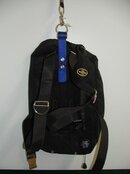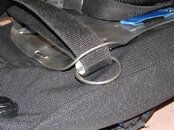I took my Rescue class in a backplate and Hog harness. It flummoxed my instructors, because they had no clue how to get somebody out of the gear (other than cut the harness, which is always an option)…
That is one of many reasons I am a proponent of allowing the shoulder webbing to slide through the backplate… pulling the belly-band tightens the shoulders. I know it varies by body type, but I can be lifted by a rescue/deadman ring (center back lift D-ring) and not fall out. I only use a crotch strap when commercial diving code requires it.
It is a simple matter to release the buckle on the belly-band and pull slack into the shoulder straps for donning, doffing, or rescue. There are several tech plates with rollers and slide options.
Besides, there are a lot of jacket BCs that are not don't have shoulder adjustment.






